How Do Firearms Work and What Sets Them Apart?

Firearms have been a source of fascination, scrutiny, and intense debate for centuries. With thousands of variants observed across the globe, all firearms share a few common fundamental workings that make them distinct from other weapons. Here we explore the core mechanisms behind the functionality of firearms and discuss how they set themselves apart from other weapons. The most significant aspect of firearms is their use of gunpowder to propel bullets or pellets out of the barrel at high velocity. This is accomplished through a controlled explosion in which gunpowder within the chamber creates pressure that propels the bullet through the barrel upon trigger activation. Other components such as rifling create a spin on the projectile for greater accuracy and power, and additional features such as recoil systems help absorb shock energy for improved operation. Firearms also offer significant versatility due to modularity and specific components can be switched or modified to suit different user needs and preferences. Although many aspects have changed over time, these key features remain largely unchanged despite advances in technology; this exceptional durability has earned firearms their status as one of the most iconic weapons ever created.
The Basic Mechanism of Firearms
- Loading
The loading action is a crucial step in the firing process of any type of firearm. It involves inserting ammunition into the weapon, thus preparing it for discharge. For single-shot firearms, such as early muskets and modern hunting rifles, this procedure entails manually placing a cartridge or bullet into the fire chamber. On the other hand, semi-automatic or automatic firearms necessitate the insertion of a magazine containing several rounds before initiating the mechanical action that loads one round at a time into the firing chamber. A successful loading process will ensure that the firearm functions correctly and efficiently when fired, making it an integral part of shooting safety protocols. Furthermore, some firearms may require additional steps such as cocking or racking prior to loading; hence it is necessary for users to be familiar with their specific instructions to ensure safe usage.
- Locking
Locking is an important part of the firing process for firearms. It serves to create a closed system that will contain high-pressure gases generated during firing, thus preventing them from escaping and causing damage or injury. The locking mechanism varies depending on the type of gun, but essentially works by securing the round loaded into the chamber prior to firing. This locks up the chamber and ensures that no additional rounds are added while in this state. The locking process must be done correctly to ensure safety and effective firing. Apart from ensuring that rounds are properly secured, locking also controls the release of propellant gasses when a round is fired, which ultimately has a direct effect on accuracy and performance. Thus, understanding and taking proper care of the locking mechanism is critical for responsible firearms usage.
- Firing
Firing a firearm is an intricate operation that requires meticulous coordination between its constituent elements and actions. When the trigger is pulled, a firing pin strikes the primer found at the base of the ammunition to spark a small detonation; this inflates pressure in the cartridge and causes a more powerful explosion, propelling the bullet from the gun. Timing is paramount for the successful execution of the sequence, as any delay can adversely affect accuracy and velocity. The propellant gasses created by this ignition rush through the barrel with astonishing strength, shoving the bullet forward at remarkable speed. To guarantee the utmost efficacy and optimize performance, every move must be closely examined and meticulously adjusted.
- Extraction
The extraction process is an integral part of any firearm, as it enables users to make successive shots with a reduced reloading cycle. By pulling back the bolt handle in the case of manual firearms, or through internal components in semi-automatic or fully-automatic weapons, spent cartridges are swiftly removed from the firing chamber and a new round is loaded into place for the shooter. This process makes for greater control and accuracy while shooting, allowing users to fire off rounds at maximum efficiency.
What Sets Different Firearms Apart?
Over many centuries, firearms have evolved into a plethora of designs. The main factors setting firearms apart are their operating system, caliber, rate of fire, and construction.
- Operating System
Operating systems for firearms are categorized based on the manner in which they facilitate the four stages of the firearm cycle: feeding, chambering, firing, and extraction. Single-shot weapons require manual operation for each stage after the first shot, while semi-automatic firearms automatically perform most stages after the initial trigger pull. Conversely, automatic firearms will continue to fire as long as the trigger is pressed down. This classification system allows users to select a firearm that best suits their needs and skill level. Single-shot weapons offer simplicity with fewer chances of misfiring or jams whereas automatic weapons provide greater power and faster shooting but must be operated by an experienced user. Understanding how these operating systems work is essential for safely handling any type of firearm and selecting a suitable weapon for any given situation.
- Caliber
The caliber of a firearm is an important measurement that can greatly affect its performance and effectiveness. It is defined as the internal diameter of the barrel or the diameter of the projectile shot from it and is typically expressed in inches or millimeters. A higher caliber typically indicates greater shooting range, power, accuracy, and stopping power. However, this also correlates with an increased amount of recoil. This means that when making a choice in regards to calibers one must consider not only their performance expectations but how they will be able to handle the recoil of the ammunition being fired. As such, selecting a suitable caliber requires careful consideration of both ammo specifications and shooter preferences to ensure optimal results. Additionally, using lower caliber ammunition when possible can help conserve resources while still providing acceptable performance in certain scenarios.
Firearms have an extensive and storied past, intertwined with humanity’s development of technology. To gain a true understanding of their operation, we must explore the intricate workings of these weapons, from ancient models to the most modern advances. As powerful instruments of change, guns continually spark spirited debates regarding their usage, regulation, and effects on society. Companies like Elevated Gunworks spearhead innovative advancements in firearm technology, playing an essential role in furthering the discourse and progress around this vital topic.






